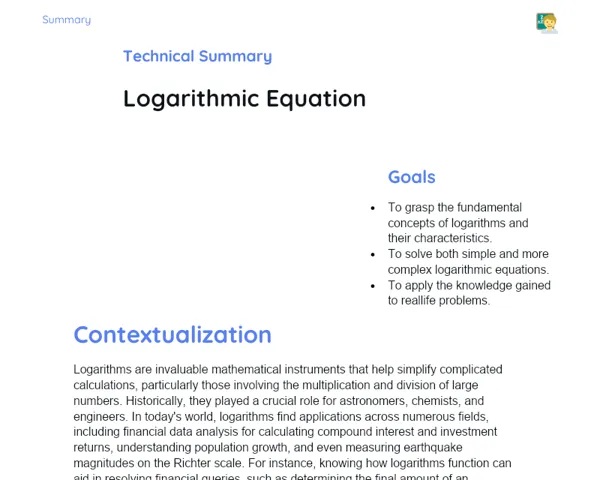Goals
1. Understand and apply the formulas for sum and difference of angles to tackle trigonometric problems.
2. Calculate the sines, cosines, and tangents of specific angles, such as 75° and 22.5°, using the formulas we've learned.
3. Hone your mathematical problem-solving skills in practical contexts.
4. Connect trigonometric concepts to real-world applications in various careers.
Contextualization
Trigonometry is a vital part of mathematics, playing a role in many aspects of our everyday lives, from engineering and architecture to technology and the sciences. Knowing how to calculate angles and distances is essential for tasks like construction, designing software, and navigation. Today, we will delve into the formulas for sum and difference of angles, which are foundational for solving complex trigonometric challenges, particularly with angles like 75° and 22.5°.
Subject Relevance
To Remember!
Sum of Angles Formula
The sum of angles formula helps you calculate the sine, cosine, and tangent of the sum of two angles. These formulas are crucial for tackling problems where the angles aren't standard and can't be readily found in trigonometric tables.
-
sin(A + B) = sinA * cosB + cosA * sinB
-
cos(A + B) = cosA * cosB - sinA * sinB
-
tan(A + B) = (tanA + tanB) / (1 - tanA * tanB)
-
These formulas are particularly handy for calculating angles like 75°, which can be broken down into 45° + 30°.
Difference of Angles Formula
The difference of angles formula is used to compute the sine, cosine, and tangent of the difference between two angles. These formulas are essential for finding specific angles when subtracting known angles.
-
sin(A - B) = sinA * cosB - cosA * sinB
-
cos(A - B) = cosA * cosB + sinA * sinB
-
tan(A - B) = (tanA - tanB) / (1 + tanA * tanB)
-
These are useful for determining angles like 15°, which can be expressed as 45° - 30°.
Practical Applications
The formulas for sum and difference of angles have a wide variety of practical applications, especially in fields that require accuracy and complex calculations. They are vital in engineering, architecture, IT, and numerous other sectors.
-
Engineering: Calculating forces in structures and determining angles for construction projects.
-
Architecture: Designing ramps, staircases, and specific slope angles in buildings.
-
Information Technology: Developing algorithms for computer graphics and graphic software.
Practical Applications
-
Calculate the angle of a ramp for an architectural project, ensuring the slope meets safety regulations.
-
Determine the force and direction of elements in a bridge to guarantee stability and safety during construction.
-
Create graphic algorithms in games and design software, applying trigonometric formulas to achieve accurate renderings.
Key Terms
-
Sine: A trigonometric function that links the angle to a specific ratio between the sides of a right-angled triangle.
-
Cosine: A trigonometric function that correlates the angle to a specific ratio between the sides of a right-angled triangle.
-
Tangent: A trigonometric function that associates the angle with a specific ratio between the sides of a right-angled triangle.
-
Angles: Referring to angles in trigonometry, often used in combinations for exact calculations.
Questions for Reflections
-
How does precision in trigonometric calculations influence the safety of construction projects?
-
In what ways is trigonometry applied in information technology, particularly in computer graphics?
-
What challenges might you encounter when applying the sum and difference of angles formulations in real-world projects?
Practical Challenge: Building a Ramp
In this mini-challenge, you will use the concepts of sum and difference of angles to determine the necessary angles needed to construct a safe and functional ramp.
Instructions
-
Form groups of 3 to 4 students.
-
Utilise the formulas for sum and difference of angles to gauge the incline angles of the ramp, ensuring they comply with safety standards.
-
Construct a model of the ramp using materials like wooden sticks and string.
-
Present your model to the class, detailing how the trigonometric calculations were employed to ascertain the required angles.



